The Event Horizon Telescope collaboration released a new image yesterday that shows the black hole in M87 once again, but this time, with new details. Using polarized light, the team was able to capture photographic evidence of magnetic fields. Plus, Jupiter’s winds, baby stars, fossilized plants under Greenland’s ice, and our weekly What’s Up segment.
Media
Transcript
Hello and welcome to the Daily Space. I am your host Dr. Pamela Gay.
And I am your host Beth Johnson.
And we are here to put science in your brain.
Today is a weird news day. There was a large stack of press releases and news articles, but it turned out most of that stack focused on new discoveries made about a supermassive black hole in the Galaxy M87. We’re going to cover that story later in the show, but before we do, we’re going to look at some of the other news that dared to compete with this research discovery blockbuster.
Our first story of the day takes our oft-stated quandary that no one really knows how planets form and extends that problem out to include the formation of stars as well. We have a big picture understanding: there are giant molecular clouds of gas and something happens that causes pockets of material to fragment and collapse into stars. That much, observationally is clear. According to new research to appear in The Astrophysical Journal, what happens next is not at all what was expected.

We had thought that stars would clear away the clouds of material around them through a combination of gravitationally pulling in material to form a cavity and then blasting that cavity larger with their stellar winds and jets. This new work, however, looks at high-resolution images from the Hubble and Herschel space telescopes and examines the differences in cavity structure around stars of a variety of different ages. According to lead researcher Nolan Habel: Our observations indicate there is no progressive growth that we can find, so the cavities are not growing until they push out all of the mass in the cloud. So, there must be some other process going on that gets rid of the gas that doesn’t end up in the star.
What that process is? No idea. But if the JWST actually launches later this year and works as hoped, it may be able to spy the answer.
As our technology advances and more spacecraft and ground-based telescopes survey our skies, we’re going to keep discovering things that defy our expectations. One of the biggest surprise identifying missions of recent times is Gaia. This ESA-run space telescope is surveying the motions of stars in the sky in a level of detail previously never achieved. In these motions, researchers are finding families of stars moving together through our galaxy: remnants of disrupted dwarf galaxies and other structures that had previously hidden in plain sight. It is also showing that previously known clusters aren’t as they appear.
In a new analysis of the Hyades Cluster and its surrounding region, researchers have identified populations of stars related to the cluster that were previously unknown. This alone isn’t that surprising; the Hyades cluster is an older group of stars, and with every passage around the Milky Way, variations in the stars’ distances from the Sun cause them to either race ahead or lag behind the cluster center, forming what are called tidal tails. Over time, the cluster will be so stretched out, we can no longer tell there was ever a cluster at all. The thing is, in looking at this region with Gaia, not everything can be explained with plan old orbital dynamics.
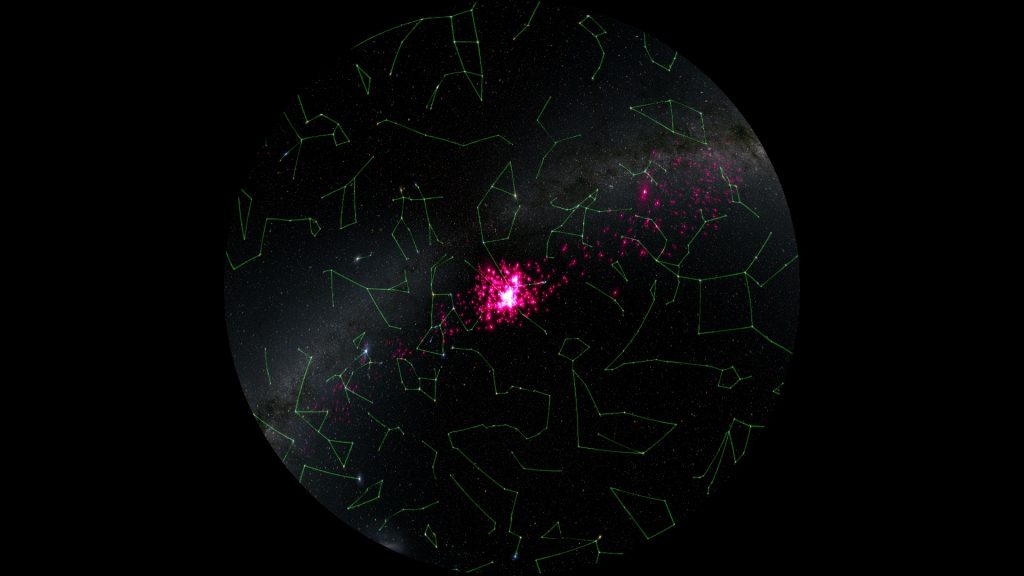
In looking at the trailing tidal tail – those stars that lagged behind – researchers found there just weren’t as many stars as there should be. To explain this discrepancy, the team ran simulations to figure out what could cause stars to disappear. In the simulations, a cloud of matter containing ten million solar masses could do the trick. As put by discoverer Tereza Jerabkova: There must have been a close interaction with this really massive clump, and the Hyades just got smashed.
The catch is that no such cloud of mass is visible in the sky. Our universe is primarily made of invisible stuff, and there are predictions of dark matter sub-halos — clumps of dark matter left from the formation of our galaxy. Jerabkova goes on to say: With Gaia, the way we see the Milky Way has completely changed. And with these discoveries, we will be able to map the Milky Way’s sub-structures much better than ever before.
This work is being published in Astronomy & Astrophysics. In follow-up research, this team will look at more clusters and see what hints of additional invisible structures are out there waiting to be discovered in the Gaia data.
Planetary scientists have used material from the 1994 crash of Shoemaker-Levy 9 into Jupiter to measure upper-level winds in Jupiter’s atmosphere. Back in 1994, the comet fragments stirred dark materials from deep in Jupiter up to the surface, where they appeared as dark smudges. Over time, this material was spread out and the spots erased from easy observation. Those unusual molecules, however, stayed in the atmosphere, and using the Atacama Large Millimeter/submillimeter Array, researchers have tracked those molecules’ motions.
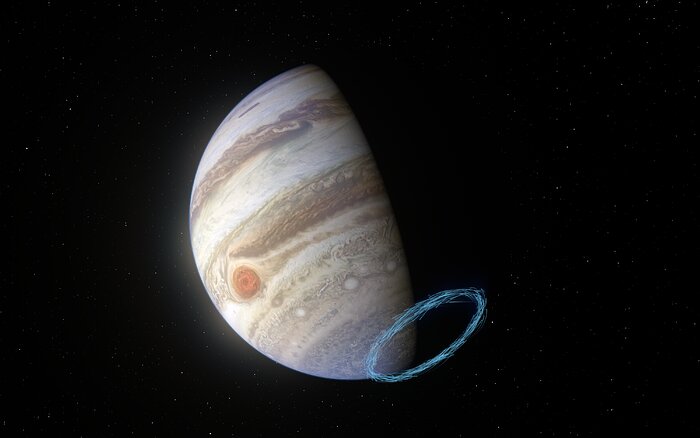
The molecule in question is hydrogen cyanide, and its speed: 900 mph. These are upper-level winds, in the Jovian polar region, with the blowing gas being located under the deck of Jupiter’s aurorae. Similar measurements in the equatorial region clocked wind jets at 370 mph. This indicates our models of Jupiter’s high-level atmosphere are pretty much wrong and hints that the future JUICE mission to Jupiter is going to work wonders on improving our understanding of this giant planet’s atmosphere.
Earlier this week, we reported on a story about how methane could seep and burst from under the Arctic seafloor as the Arctic ice sheet melts. Scientists used sediment core samples and radiometric dating to understand some naturally occurring warm periods in the Earth’s past. Today, scientists have done something similar to understand the dangers for Greenland’s ice sheet. And the results are not any better for us.
This story starts, though, back in the 1960s. The Cold War was quietly raging, with both sides playing terrible games to one-up the other with “my arsenal is bigger than your arsenal” and then hiding how that might be true. Under the guise of scientific research, the U.S. Army built Camp Century in Greenland. Ostensibly a site to test construction techniques under Arctic conditions, in particular sub-glacial construction. However, documents declassified in the 1990s showed that the actual intent was to house a large number of missiles aimed at the Soviet Union. That never happened for a variety of reasons, not the least of which was the lack of desire to get permission from the Danish government.
Appearances must be kept up, though, so ice core samples were taken at the site. One of those cores was 1400-meters deep and included 4.5 meters of the ground below all the ice. Then the soil was put in a freezer and basically lost for decades. Until now.
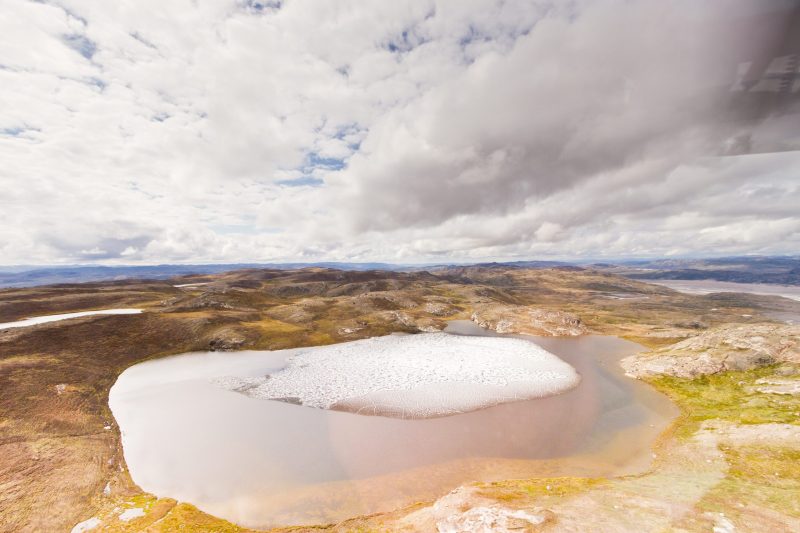
The soil samples were rediscovered in 2017, and numerous scientists around the world have taken the opportunity to study and analyze the contents. In research published this month in the Proceedings of the National Academy of Sciences, a team led by Andrew Christ present their findings. And what a find it was. The soil samples contained not sand and rock but fossilized twigs and leaves. Sometime in the past million years, Greenland’s ice sheet was gone, and Greenland really was, well, green.
The scientists involved in the research used a variety of modern techniques to understand these fossils. Carbon dating won’t work due to the relatively short half-life of radioactive carbon, so instead, isotope ratios of aluminum and beryllium were measured. These isotopes only form in quartz when the mineral is exposed to cosmic rays, and over a kilometer of ice ensures that doesn’t happen. So then we know when the minerals were exposed.
Other techniques included oxygen isotope ratio measurements, studies of luminescence, and analyzing the actual arrangement of the layers. Everything came back to the upper part of the sediment having been reburied around one million years ago. That upper sediment matches subglacial bedrock found in central Greenland, suggesting the history is similar across the ice sheet. And there were two distinct periods of warmer, ice-free, vegetated ground.
The concern here is that the processes that caused Greenland’s ice sheet to melt were purely natural and not anthropogenic as we’re currently experiencing. That means that this ice sheet isn’t as durable as we thought previously, which is pretty darn scary. The loss of the ice sheet due to climate change means all that newly liquid water enters our oceans, and that would, in turn, lead to a global sea-level rise of six meters. Pick a coastal city. Any coastal city. And it’s in trouble.
This problem is one we need to solve, as a global society, sooner rather than later. We’ll continue to update you all about any progress made as we learn of it.
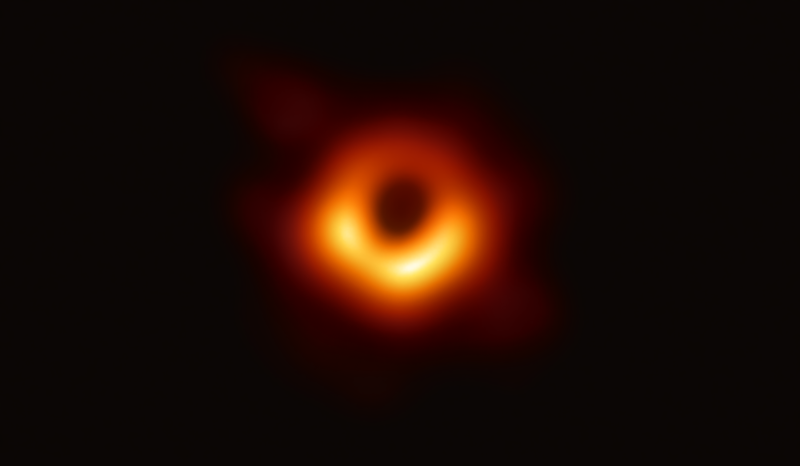
Back in April 2019, news sites around the world carried pictures of a strange donut of light with headlines stating astronomers had imaged the event horizon of a black hole for the first time. That supermassive black hole is in the heart of the M87 galaxy, located 55 million ly away, and it was imaged by the Event Horizon Telescope, which was actually a massive network of radio telescopes scattered around the world that worked together to image this gravitationally distorted light. In the years since that release, the team has continued to process the data and to obtain even more data, and today we learned that their images allow them to see the effects of the black hole’s magnetic field. According to team member Angelo Ricarte: One of the main science drivers of the EHT is distinguishing different magnetic field configurations around the black hole.
To trace M87’s magnetic field, the team looked at how much light they received that was oriented in different ways. If you’ve ever tried looking at the LCD screen on a camera with polarized sunglasses, you may have noticed the picture completely goes black when you rotate the camera. This is because polarized glasses only allow light that is aligned in a certain direction to pass through.
Lightwaves are traveling in a specific direction, and their wave component is aligned in a specific way in relation to that direction. Filters, like those in your polarized sunglasses or in a polarized light camera filter, can reveal how the light gets aligned as it scatters off the dust, clouds, and road in front of you, and are in fact designed to reduce the glare of scattered light off the road. The eight telescopes involved in this work, which is published in a trio of papers in The Astrophysical Journal Letters, looked at how magnetic field lines aligned the light as seen via the lights’ polarization.
In the image, which you can see on our website, you can see lines marking where polarized light indicates magnetic field lines are present. According to Andrew Chael: The newly published polarised images are key to understanding how the magnetic field allows the black hole to ‘eat’ matter and launch powerful jets.
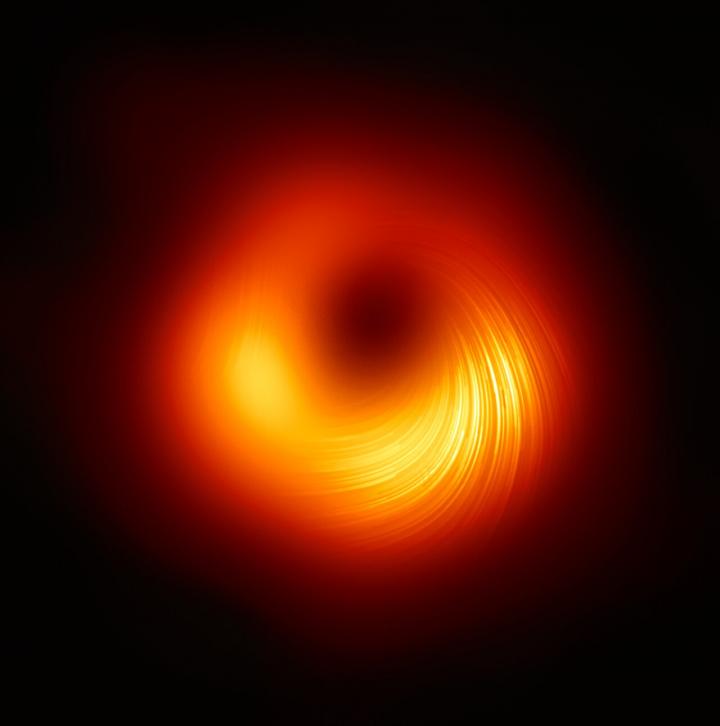
Jason Dexter adds: The observations suggest that the magnetic fields at the black hole’s edge are strong enough to push back on the hot gas and help it resist gravity’s pull. Only the gas that slips through the field can spiral inwards to the event horizon.
This work used data that is now several years old, and with every passing season, our technology improves, and EHT collaboration members are already hoping to repeat these observations with this new tech and with additional telescopes. According to Jongho Park: The EHT is making rapid advancements, with technological upgrades being done to the network and new observatories being added. We expect future EHT observations to reveal more accurately the magnetic field structure around the black hole and to tell us more about the physics of the hot gas in this region.
The thing I personally find most pleasing about this research is that, so far, there are no real surprises. Models that include relativity had been able to accurately predict how the light would be bent and shaped in this enormous gravitational field, and now we’re seeing the details of a magnetic field we thought had to be there all along. As much as we may struggle with theories like planet formation and the stars they formed around, black holes make sense. Isn’t science weird sometimes?
What’s Up
Our next story is about astronomy, just in a roundabout way.
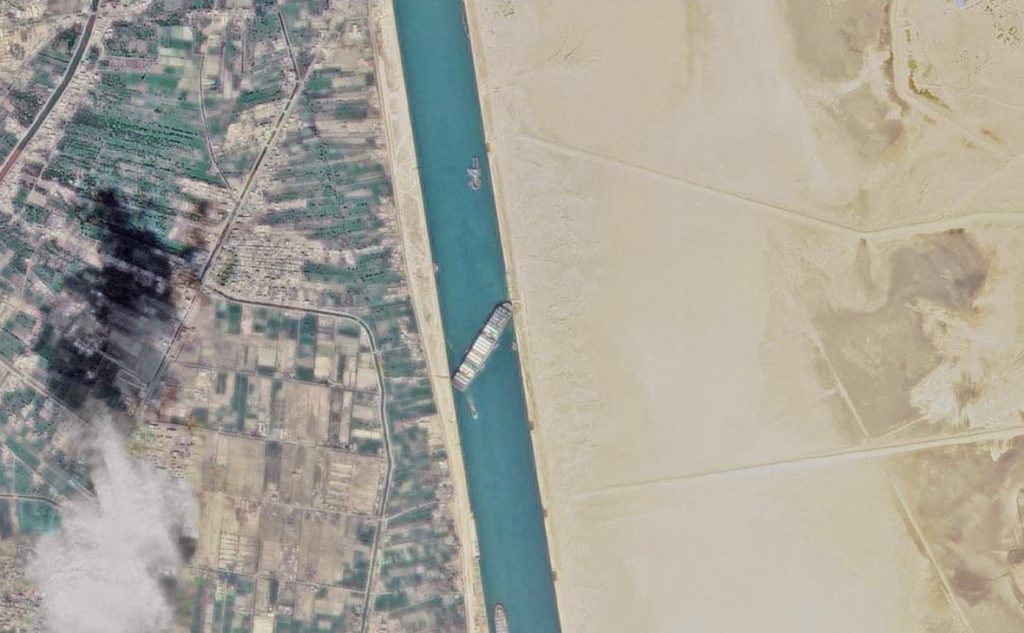
Earlier this week a large container ship ran aground in the Suez Canal, where it is currently still blocking [Ed. note: Not anymore!] all maritime traffic through one of the busiest waterways in the world. The vessel, named the Ever Given, measures 400 meters long and 59 meters wide, making it one of the largest container ships in the world and challenging to navigate through the relatively narrow Suez Canal.
In an image from the Russian satellite Canopus-B, you can get a sense of just how stuck this ship is, and a hint at its size, which is essentially the size of the Empire State Building laid on its side!
Navigation in the Suez was made even more challenging for the Ever Given by a sandstorm and 50-kilometer winds, which caused the ship to lose control and hit the bottom of the canal. Satellite images show the Ever Given sitting diagonally across the entire width of the canal. Reports say it’s going to take days, maybe even weeks, to refloat the ship and allow traffic to resume.
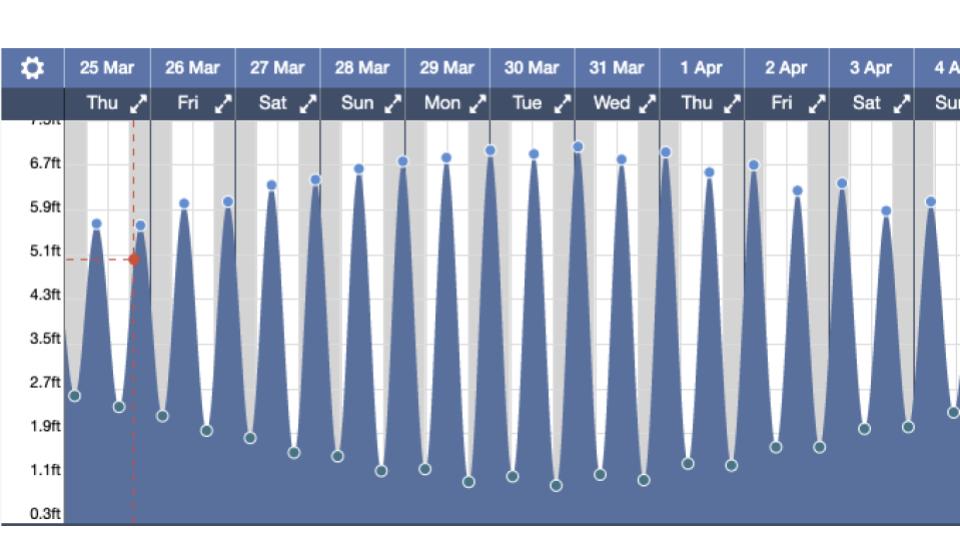
According to a 2019 paper published in the Journal of Marine Science and Engineering, terminals and waterways are struggling to accommodate so-called mega container ships like the Ever Given. Due to safety concerns, vessels longer than 400 meters need permission from the Suez Canal Authority to transit the canal, putting the Ever Given right at the max length. Likewise, the ship’s beam and draft — that is, the breadth of the ship at its broadest point and the vertical distance between the waterline and keel — are barely within the maximum allowable through the canal. This means there is almost no room (literally and figuratively) for error. It also raises concerns about the safety of allowing larger and larger ships through the canal. The Ever Given is the fourth ship to run aground in the Suez since 2016.
We have to admit that we’re out of our depth when it comes to shipping, and Ally, who was a project manager for a global shipping company – and who is currently very glad she is now a producer for us and not involved in this particular nightmare – wrote the earlier portions of this story.
Now, what does this have to do with astronomy? The first thing I did when I heard about this grounding was pull up a tidal chart of the Suez Canal.
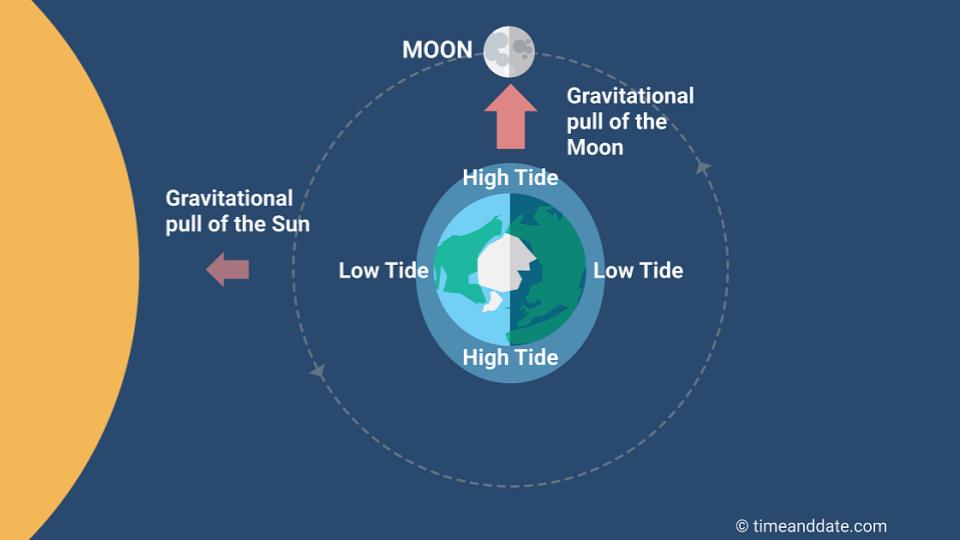
Over the course of the month, the timing of the tides, and the highs and lows of the high and low tides all vary with the phase of the Moon. Ideally, you want to put a boat like this through on the highest of high tides, which is not what they did. When the boat ran aground on Tuesday, the Moon was just past first quarter.
When the Moon and the Sun are at right angles in the sky, we see only half of the Moon illuminated, and the tides are just not as high or low because the Sun and Moon are pulling on the Earth at cross-purposes.
The next full Moon comes on Sunday, and it brings with it higher tides. The exact time of the highest tide actually lags a bit thanks to everything rotating, and my early fear was they’d need to wait for that higher high tide to get things moving again.
In a new article appearing in Bloomberg, Lucia KAssai and Robert Tuttle report that it’s now official: that Monday tide is being seen as the best bet to get this boat free.
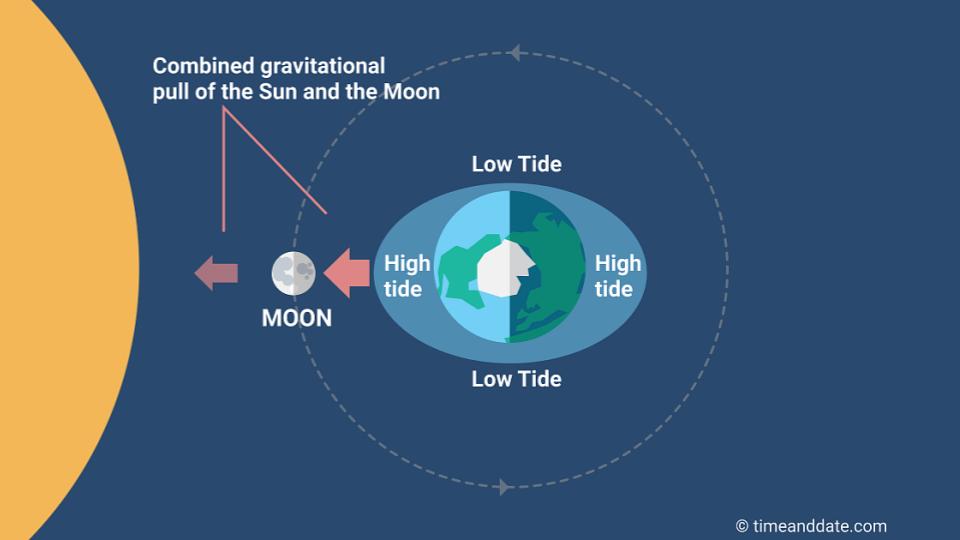
Each day, we experience two high tides: one when the Moon is almost but not actually straight overhead, and one when the Moon is almost straight beneath our feet. That is because planetary rotation carries the tide ahead of the Moon.
Low tides come just before moonrise and just before moonset. If you’re ever at the beach you can now surprise your friends by looking at the Moon and knowing the tide, at least if the moon is in the sky. But hey, this gives you one chance a day, most days, to show off your astronomy knowledge.
This has been the Daily Space.
Learn More
Baby Stars Carve Out Cavities in Gas Clouds, Keep Growing
- NASA press release
- “An HST Survey of Protostellar Outflow Cavities: Does Feedback Clear Envelopes?,” Nolan M. Habel et al., to be published in The Astrophysical Journal (preprint on arxiv.org)
Gaia Satellite Finds Hyades Cluster Being Pulled Apart
- ESA press release
- ESA video
- “The 800 pc long tidal tails of the Hyades star cluster,” Tereza Jerabkova et al., 2021 March 24, Astronomy & Astrophysics
Stratospheric Winds Measured on Jupiter Using ALMA
- SwRI press release
- ESO press release
- “First direct measurement of auroral and equatorial jets in the stratosphere of Jupiter,” T. Cavalié et al., 2021 March 18, Astronomy & Astrophysics
Fossilized Plants Found Deep Beneath Greenland Ice Sheet
- EarthSky article
- “A multimillion-year-old record of Greenland vegetation and glacial history preserved in sediment beneath 1.4 km of ice at Camp Century,” Andrew J. Christ et al., 2021 March 30, PNAS
Event Horizon Telescope Images Black Hole’s Magnetic Fields
- Center for Astrophysics | Harvard & Smithsonian press release
- ESO press release
- Event Horizon Telescope press release
- NRAO press release
- University of Massachusetts Amherst press release
- University of the Witwatersrand, Johannesburg press release
- “First M87 Event Horizon Telescope Results. VII. Polarization of the Ring,” The Event Horizon Telescope Collaboration et al., 2021 March 24, The Astrophysical Journal Letters
What’s Up: Lunar Tides and the Suez Canal
- Large container vessel Ever Given blocks Suez Canal (Ship Technology)
- “Tendency toward Mega Containerships and the Constraints of Container Terminals,” Nam Kyu Park and Sang Cheol Suh, 2019 May 6, Journal of Marine Science and Engineering
- Suez Canal blockage: how cargo ships like Ever Given became so huge, and why they’re causing problems (The Conversation)
- Here’s how the full moon helped free the stuck ship Ever Given in the Suez Canal (Space.com)
- What Causes Tides? (timeanddate.com)
Credits
Written by Pamela Gay, Beth Johnson, and Ally Pelphrey
Hosted by Pamela Gay and Beth Johnson
Audio and Video Editing by Ally Pelphrey
Content Editing by Beth Johnson
Intro and Outro music by Kevin MacLeod, https://incompetech.com/music/

 We record most shows live, on Twitch. Follow us today to get alerts when we go live.
We record most shows live, on Twitch. Follow us today to get alerts when we go live.